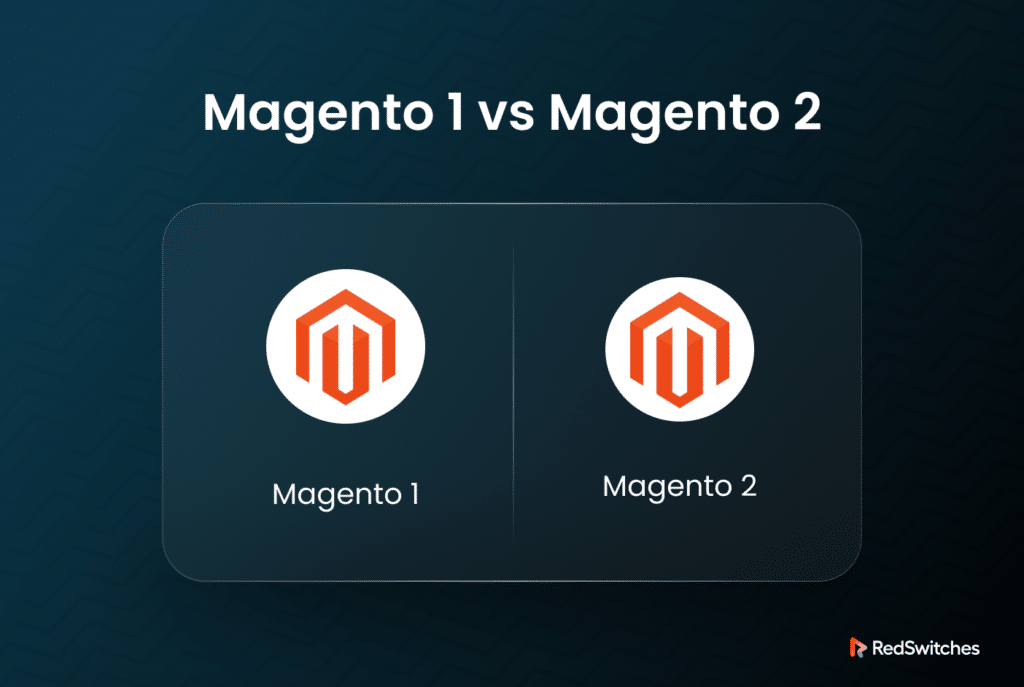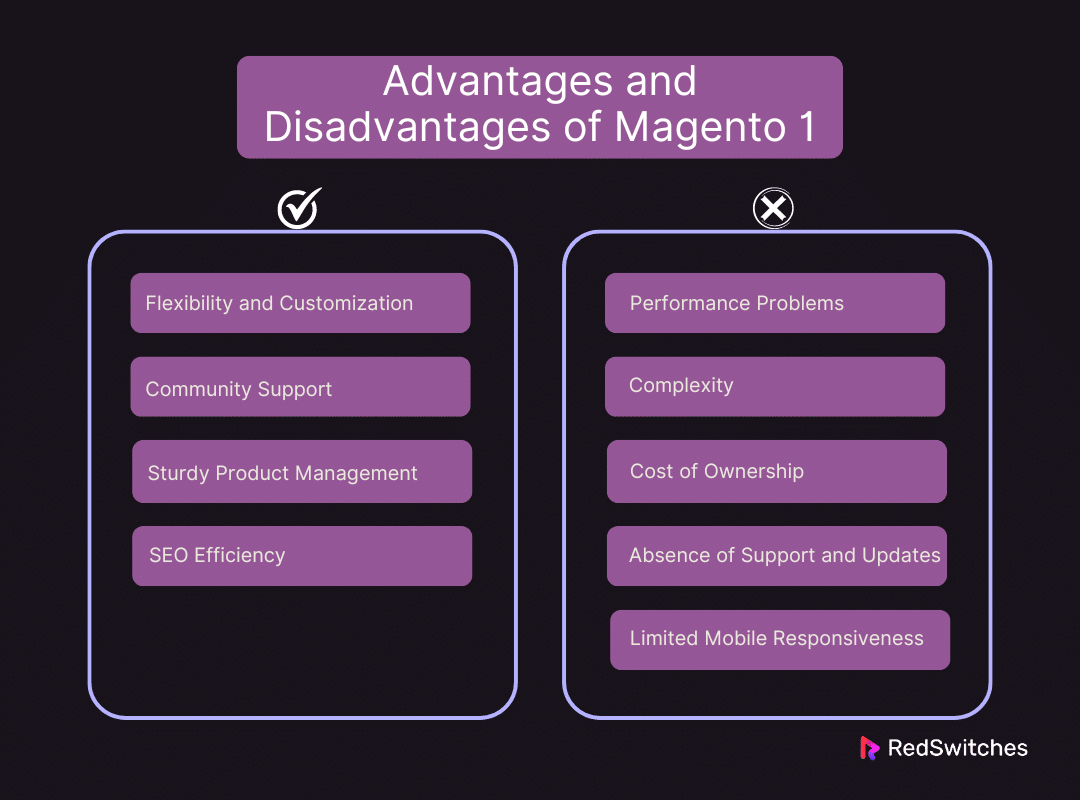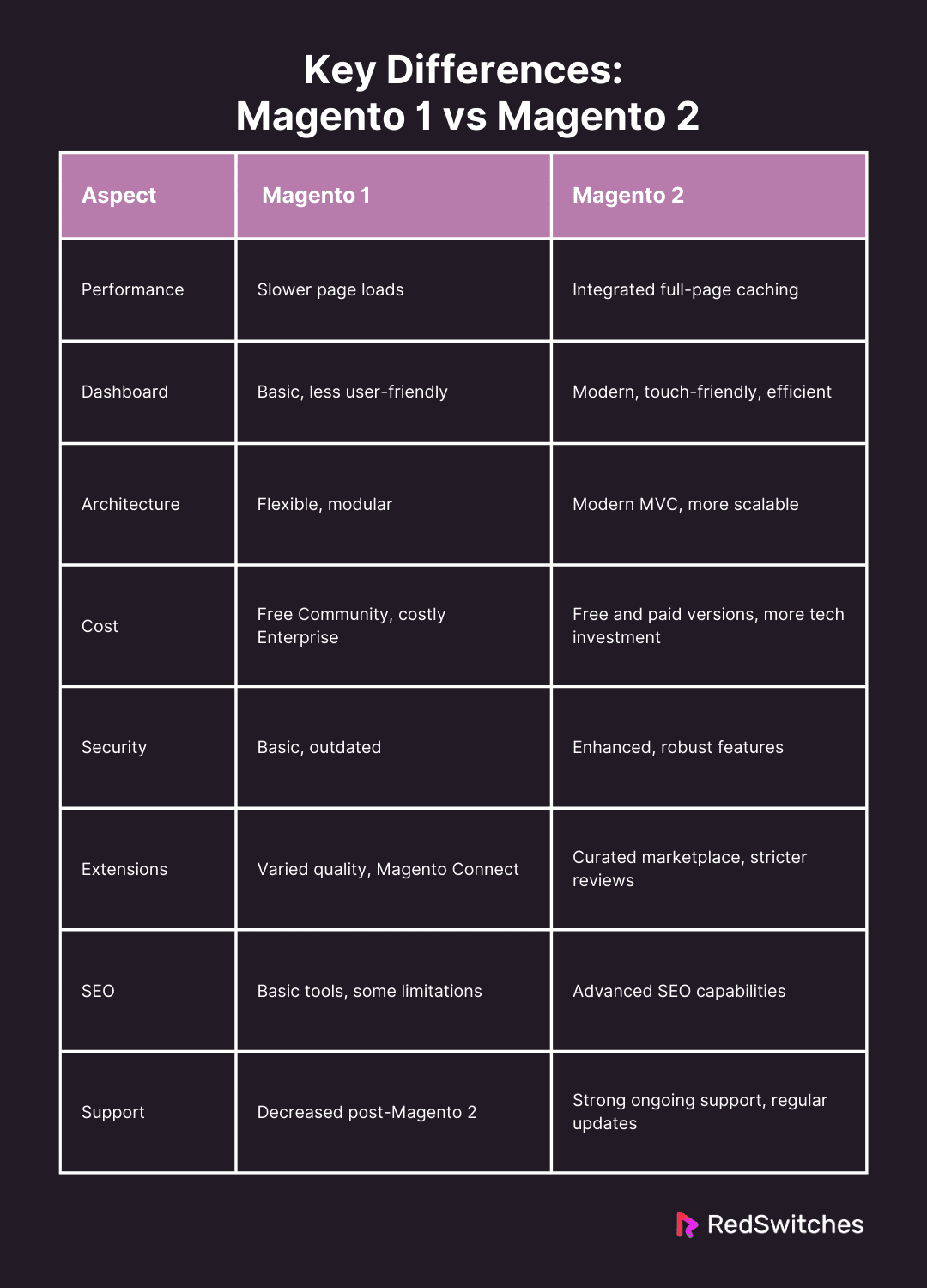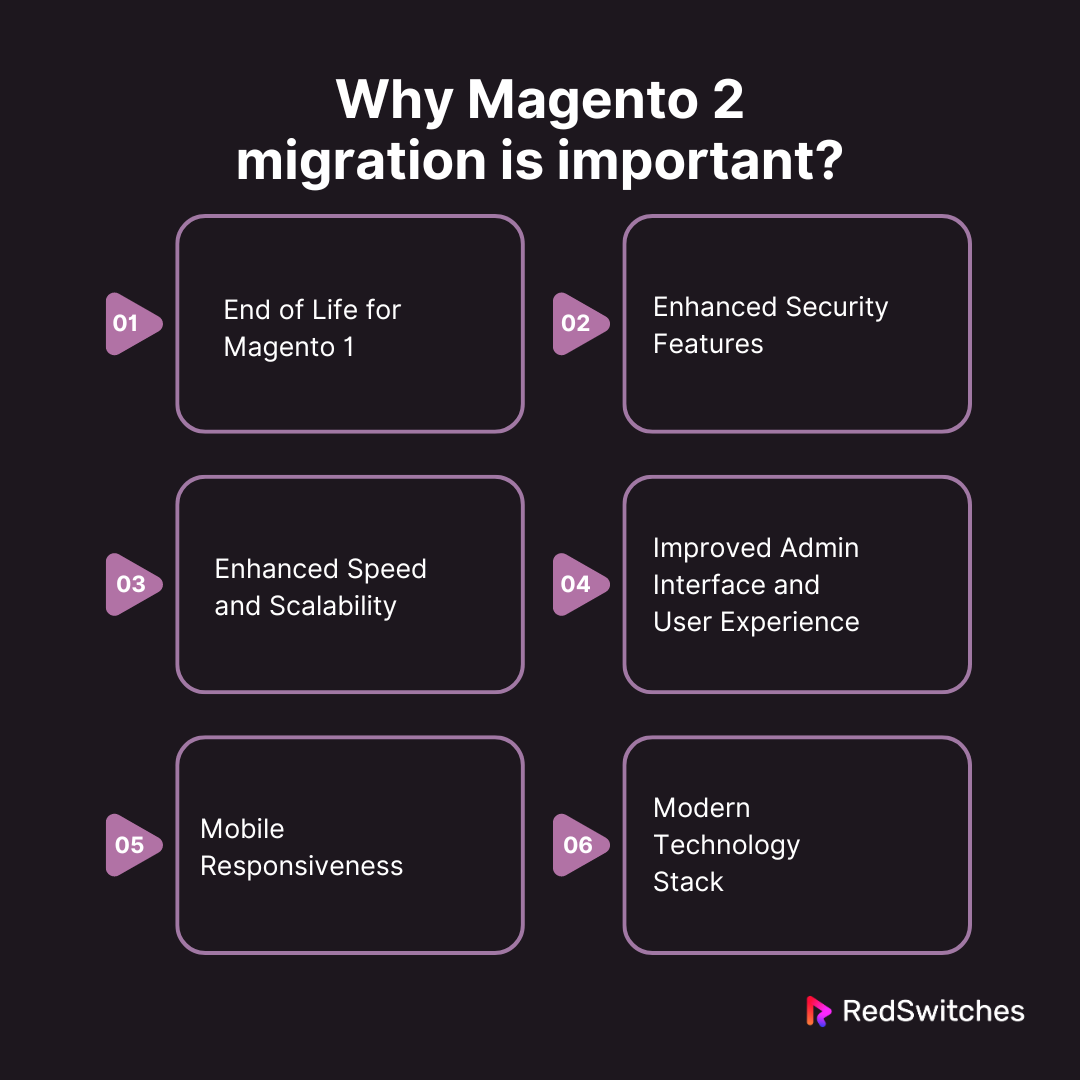Key Takeaways
- Magneto 1 has been a powerful, open-source eCommerce platform known for its robust features.
- While Magneto 1 offers flexibility and features, migrating to Magento 2 may impact performance, security and mobile support.
- Magento 2 offers superior performance and a user-friendly experience for your interface.
- Streamlined checkout improves sales conversions.
- Improved admin interface enhances usability.
- More robust security features protect data.
- Mobile-first approach boosts the shopping experience.
- Magento 2 supports advanced technologies like PHP 7.
- Migration to Magento 2 is essential for future-proofing eCommerce.
Magento is making waves in the digital commerce landscape. It’s not only you who’s struggling to decide whether to stick with Magento 1 or go to Magento 2. Even though Magento has long dominated the eCommerce space, our tools need to keep up with technological advancements. For many, Magento 1 has been dependable. However, Magento 2 offers a number of enhancements. It will satisfy the expanding demands of internet shopping.
In this blog post, we’ll dive into the main differences between these two versions. We’ll focus on their features, performance, and compatibility with recent eCommerce developments.
This comparison will reveal the best Magento version for your online success. Whether you are a developer, entrepreneur, or tech enthusiast, it doesn’t matter. Let’s examine the features of each platform and determine which would be best for your online store requirements Magento 1 vs Magento 2.
Table of Contents
- Key Takeaways
- What is Magento 1
- Advantages of Magento 1
- Disadvantages of Magento 1
- What is Magento 2?
- Advantages of Magento 2
- Disadvantages of Magento 2
- Key Differences: Magento 1 vs Magento 2
- Why is Magento 2 migration important?
- Conclusion
- FAQs
What is Magento 1
Credits: Freepik
March 2008 saw the first release of Magento 1. It is an open-source eCommerce platform. It was made by Varien Inc., which later changed its name to Magento Inc. It became well-known because of its strength, adaptability, and comprehensive feature set. These features enabled very customizable online stores. Magento 1’s design aimed to help online retailers. They wanted to offer their clients a fully customized shopping experience. It includes many features, from advanced marketing and customer management capabilities to product display and payment processing.
The platform had two main editions. The first was Magento Enterprise Edition, a premium version for large enterprises with special needs. It had more features, support, and services. The second was Magento Community Edition, a free version for developers and tech-savvy merchants. Because of this structure, Magento 1 could serve a wide range of customers. These included start-ups to major corporations, all of which could use the platform’s features.
Because of its comprehensive customization options, Magento 1 stood out in the market. It had robust features. These included an adaptable shopping cart. It could run several stores. It also had an extensive marketplace with add-ons and themes. The platform has a flexible architecture. Developers could add many plugins and modules to improve the shopping experience.
Advantages of Magento 1
During its heyday, Magento 1 offered a number of benefits that made it a strong and desirable choice for eCommerce companies. Here’s a thorough analysis of a few significant benefits:
Flexibility and Customization
Magento 1 had modular architecture. It was open-source. It gave unmatched flexibility. It lets developers modify and improve the platform. This customization went far beyond practicality. It went into aesthetics. It allowed for a wide range of engaging user experiences to be developed. Without jeopardizing the integrity of essential system files, developers could create unique extensions and themes that made it easier to customize the eCommerce store to meet the needs of different business models and consumer markets. Magento’s strong API support, facilitating simple connections with third-party apps, further strengthened its appeal to firms requiring a non-standard approach to their online presence.
Community Support
The Magento 1 community was sizable and vibrant, with service providers, developers, and users joining forces to create a robust support system. With the help of this community, a robust ecosystem of plugins and themes, as well as a wealth of bespoke solutions, shared experiences, and educational resources, have all been developed. Frequent get-togethers, discussion boards, and developer conferences promoted cooperation and creativity, significantly lowering the learning curve for novice users and boosting the platform’s potential via group intelligence and cooperative problem-solving.
Sturdy Product Management
Magento 1’s user-friendly backend, which supported a wide range of product kinds and intricate setups, made it an excellent tool for managing intricate product catalogs. Multiple product attributes could be managed by this system with ease, allowing for rich user experiences with dynamic product filters and search possibilities, as well as extensive product categorization. Because of its sophisticated pricing features, merchants were able to improve their marketing and sales strategies by implementing promotions, tier pricing, and special pricing that could be customized for different client groups. Magento 1 was especially well-suited for larger shops that required intricate supply chain logistics and thorough stock management, as it could manage extensive inventories across numerous locations.
SEO Efficiency
Magento 1 offered businesses powerful options to optimize their online stores in the field of SEO. Its integrated SEO tools aim to make stores as visible as possible in search engine results. The platform allowed for the implementation of Google sitemaps, complete control over meta-data, and custom URL keys—all of which are SEO best practices. Furthermore, CMS pages and blocks made it simple for Magento 1 stores to manage content, boosting the capacity to produce SEO-rich material that increased visibility and engagement. These characteristics made Magento 1 an effective platform for increasing internet exposure and generating organic traffic.
Disadvantages of Magento 1
Despite its extensive feature set and broad appeal, Magento 1 had several drawbacks that companies had to deal with. Decisions to update or move platforms were often influenced by these problems. This was especially true as eCommerce tech advanced. Here is a thorough analysis of some of Magento 1’s main drawbacks:
Performance Problems
Magento 1 needed a lot of resources. This could cause performance problems, especially in low-capacity hosting settings. Stores need stable hosting settings to perform well. The platform’s high CPU and memory use was a trade-off for its wide features and flexibility. Longer page loads and response times could hurt sales and customer satisfaction. They could raise costs and harm user experience.
Complexity
Magento 1 was flexible and robust. These were essential benefits. But, they also made it intricate. The site had a high learning curve, particularly for inexperienced users who weren’t tech-savvy. A solid grasp of Magento 1’s fundamental design and programming abilities was necessary for managing the site, making it difficult for smaller merchants or private users without the resources to pay professional developers. Customization and troubleshooting were quite complicated and frequently required expert help.
Cost of Ownership
The operation of Magento 1, especially the Enterprise Edition, may be highly costly. Although the Community Edition was free, investing significant money in custom programming, extensions, and themes was frequently necessary to get the most out of the platform. The increased demands on server performance also meant that hosting expenses could be substantial. The upkeep, security, and updating of a Magento 1 website additionally increased the total cost of ownership because these duties frequently required specialized knowledge.
Absence of Support and Updates
After Magento 2 was released and took center stage in development, Magento 1 began to fall behind in terms of new feature releases and updates. Support for Magento 1 dwindled over time until finally, it was discontinued officially. Due to this, retailers using Magento 1 were left without essential security patches and updates, leaving them vulnerable to security lapses and possible data breaches—which could be disastrous in the data-sensitive world of eCommerce.
Limited Mobile Responsiveness
As mobile commerce grew in importance, Magento 1 found it difficult to keep up in its later years. Due to the platform’s fundamental lack of a mobile-first design, it became a major disadvantage as customer behavior started to change towards mobile shopping. While some themes and extensions increased mobile responsiveness, creating a shopping experience genuinely optimized for mobile devices frequently took time and money.
Also Read, 50 Top Trending Products to Sell Online At Your Ecommerce & Dropshipping Store in 2024.
What is Magento 2?
Credits: Freepik
The next-generation eCommerce platform, Magento 2, was formally introduced in November 2015 as a significant improvement over Magento 1. With a slew of new features, enhanced speed, and improved user experience, this update aims to rectify many of its predecessor’s faults. With a focus on scalability, speed, and enhanced admin features, Magento 2 was created to give businesses an even more robust and effective platform for managing and growing their online stores.
Regarding technology, Magento 2 debuted a redesigned architecture that was more adaptable and contemporary. It included cutting-edge technologies like PHP 7, significantly lowering server load and enhancing response times. Additionally, Composer was used by the platform to manage dependencies, making software component upgrades and installations more straightforward. A more capable and user-friendly admin interface was another feature of Magento 2, which made data analysis, order processing, and product management more effortless. Given the popularity of mobile computing, the interface’s optimization for mobile devices made it usable and accessible when on the go.
With the introduction of a shortened checkout process that lowered steps and necessary information to lower cart abandonment rates and increase conversion rates, Magento 2’s user experience experienced notable improvements. In addition, the platform improved the built-in full-page caching and added Varnish as a suggested page caching solution. These changes significantly increased page load speeds when compared to Magento 1.
Advantages of Magento 2
Credits: Freepik
Magento 2 is an improved version of Magento 1. It has new features and improvements. They fix the flaws of Magento 1. They also add powerful new capabilities. Here’s a thorough analysis of Magento 2’s main benefits:
Enhanced Performance and Scalability
Magento 2 speeds up query processing. It also optimizes database access and improves page loading times. It does this through full-page caching. This is vital for eCommerce platforms. Significant transactions and searches can slow them down. When technologies like Varnish Cache are added, the material is served more quickly. This lowers server strain and improves the user experience during high traffic. Furthermore, Magento 2 makes it simpler for online retailers to scale, meeting the demands of rapidly expanding capacities and handling a surge in inventory, clients, and orders without compromising efficiency.
Streamlined Checkout Procedure
Magento 2 offers a more intelligent and efficient checkout procedure. Its checkout process is two steps instead of six, significantly shortening the time to complete a cart. Additionally, the checkout is made to handle guest checkouts with ease. It uses email addresses to recognize repeat clients. It offers them a faster checkout with remembered shipping and preference information. This quick checkout lessens customers’ usual annoyances. It lowers abandonment and raises conversion rates.
Improved Admin Interface
Thanks to the admin interface’s drag-and-drop layout tool, users can customize the back of Magento 2. They can do this without knowing any code. Teams in charge of marketing and merchandising will find this especially helpful. They can use it to quickly modify their store layouts. Comprehensive data dashboards, which offer crucial business information at a glance and aid in improved decision-making, are another feature of the new interface. The admin panel’s adaptable design ensures that shop management duties can be effectively completed on tablets and smartphones, enabling merchants to manage their stores while on the go.
Mobile Responsiveness
The built-in themes of Magento 2 are all responsive and readily usable, reflecting the platform’s strong emphasis on mobile responsiveness. These themes ensure that all devices’ shopping experience is optimized by fluidly adapting to various screen sizes and resolutions. Additionally, Magento 2 is compatible with PWA (Progressive Web App) technology, which enables the development of online apps that provide a mobile app experience close to that of a native app. This includes faster page loading, push notifications, and offline surfing.
Advanced Security Features
Strong data encryption based on SHA-256 for passwords is one of Magento 2’s enhanced security features, making it very difficult for attackers to access client accounts. Additionally, the platform complies with PCI Data Security standards by default, guaranteeing safe payment processing. Furthermore, Magento 2 consistently provides security patches and upgrades that tackle diverse vulnerabilities, providing defense against novel attacks as they surface. Furthermore, Magento 2’s admin interface features two-factor authentication, offering extra protection against unwanted access.
Disadvantages of Magento 2
Credits: Freepik
Magento 2 has several drawbacks. Companies should consider them before using the platform, despite its many improvements over Magento 1. Here’s a thorough analysis of some of the main issues and disadvantages of Magento 2:
Complexity & Learning Curve
Magento 2 is an eCommerce platform with great functionality, but it may be tough to use due to its complexity. The platform has a severe learning curve, particularly for users from Magento 1 or other less complex eCommerce platforms. Its advanced features and functions are good. But they also add to the complexity of learning. Magento 2 development is productive. But, developers often need to grasp complex ideas and technologies. These include Composer, CLI, and frameworks like Knockout.js.
High Development and Maintenance Costs
The intricacy of Magento 2 is directly related to increased development and maintenance expenses. Building a Magento 2 store usually requires a group of skilled developers, which can be expensive. This is especially true for small and medium-sized businesses. Additionally, modifying the platform to satisfy particular business needs frequently necessitates significant development work, which raises expenses even more. While necessary for preserving the platform’s health, regular upgrades and security patches also call for developer involvement, which raises the cost of continuing maintenance.
Resource-Intensive
Magento 2 is still a resource-intensive platform that requires hosting solid solutions, which may increase your operating expenses. Its scalability and robust functionality come at the cost of ample server resources, such as CPU and memory. Smaller shops might not have the financial means to purchase a dedicated hosting environment or a cloud solution for Magento 2 to get optimal performance.
Also Read, Alibaba vs AliExpress: Navigating the E-Commerce Landscape.
Key Differences: Magento 1 vs Magento 2
Credits: Freepik
In this section, we will explore the core part of our blog i.e. key differences between Magento 1 and Magento 2. Let’s explore.
Performance
Magento 1
Despite its robustness, Magento 1 had performance problems, primarily because of its architecture and the absence of full-page caching in the default configuration. Slower page loads were a common issue with Magento 1 websites, which might adversely affect both SEO rankings and user experience.
Magento 2
On the other hand, Magento 2, created to meet the demands of modern eCommerce better, delivers notable performance and scalability enhancements. It has full-page caching integrated right in, which significantly lowers page load times and improves user experience overall.
Dashboard
Magento 1
The dashboard was Magento 1’s primary interface for controlling and monitoring the various facets of an online store. It offered quick access to fundamental data, such as the average order amount, recent orders, previous search keywords, and basic sales figures.
Magento 2
The dashboard was much better in Magento 2, with greater efficiency and ease of use. With a cleaner, more contemporary look that is also touch-friendly, the admin interface has been overhauled to improve user experience and make it simpler to use on tablets and mobile devices.
Architecture
Magento 1
Magento 1’s architecture is built on a flexible modular structure that allows custom modules to augment or replace essential functionality without changing the core code. One of Magento 1’s advantages was its modularity, which allowed for a great deal of customization.
Magento 2
The architecture of Magento 2 has been dramatically updated and modernized to improve usability, scalability, and performance. The modern MVC methodology is adopted by this new design, which adds features like Dependency Injection and Aspect-Oriented Programming to enable better code management and customization.
Cost
Magento 1
Magento 1 was available in two primary editions: the Enterprise Edition, which was a premium version that required a substantial yearly subscription cost, and the Community Edition, which was free and open-source. Small and medium-sized businesses found the Community Edition of Magento 1 attractive because it was free to use, but it lacked the Enterprise Edition’s sophisticated features, support, and performance improvements.
Magento 2
The fee structure saw a slight alteration with the release of Magento 2. Additionally, Magento 2 comes in many variants, such as Commerce (formerly known as Enterprise Edition) and Open Source (formerly Community Edition), the latter of which has both an on-premises and a cloud-hosted version. Although Magento 2 Open Source is free to download and use, its more complex technology stack usually requires more work to develop and customize than Magento 1.
Security
Magento 1
When Magento 1 was first released, it had some relatively strong fundamental security measures. It was compatible with the custom security updates that Magento often provided to fix bugs found in the platform. But as the platform became older, security issues became more prevalent. Magento 1 is not pre-installed with contemporary security features like two-factor authentication or robust password hashing algorithms.
Magento 2
With Magento 2, security measures were significantly improved. Stronger built-in protections were introduced to reduce risks and increase the platform’s credibility. It uses more recent security techniques, like hashing passwords with SHA-256, to increase password resistance.
Also Read, PrestaShop vs WooCommerce: Best eCommerce Website Tool for 2024
Extensions
Magento 1
Magento 1 gained popularity due to its rich ecosystem of add-ons that let retailers enhance and personalize the features of their online businesses. The central place to get these extensions was the Magento Connect shop, which offered thousands of alternatives created by a community of outside developers. However, due to Magento Connect’s rather lax submission and approval procedures, there was a wide range in the security and quality of these extensions.
Magento 2
How extensions are handled in Magento 2 changed to alleviate many of the issues that Magento 1 users had. A stronger emphasis is placed on quality and security criteria in the newly curated Marketplace for Magento 2 extensions. The extensive review process that Magento 2 extensions must go through, which includes technical, marketing, and business value reviews, has helped to raise the general standard and security of the now available extensions.
SEO
Magento 1
Magento 1 gave merchants the tools they needed to optimize their online storefronts and laid a solid basis for SEO. These featured tools for maintaining sitemaps and robots.txt files, meta-data for products and categories, and URL structures optimized for search engines. However, Magento 1’s handling of SEO has certain built-in limitations.
Magento 2
Magento 2 brings about some improvements that outperform Magento 1’s SEO skills. Numerous issues with the previous version are fixed, including how duplicate content is handled and more robust data structure options are available. Essential for SEO, Magento 2 automatically creates a product meta title, description, and keywords.
Support
Magento 1
Magento 1 enjoyed robust community and official channel support throughout its heyday. Users were assisted in navigating the platform’s intricacies by third-party resources, developer tutorials, and extensive community-driven forums. However, with the release of Magento 2 and its subsequent ascent to prominence as the main platform for innovation and development, official support for Magento 1 decreased.
Magento 2
Adobe is a strong official supporter of Magento 2 and will continue to release security patches, upgrades, and new features on a regular basis. This assistance depends on the upkeep of Magento 2 websites’ security and functionality, which also helps shield them from emerging security risks and guarantees their interoperability with emerging technologies and web standards. Moreover, Magento 2 users can avail themselves of comprehensive technical help, including optimization and troubleshooting, by connecting with Adobe Commerce, a professional support network.
Let’s summarize it in a tabular format.
Why is Magento 2 migration important?
The key factors supporting the importance of the migration from Magento 1 to Magento 2 are enhanced functionality, security, and support. The following are some justifications for why businesses must undertake this migration:
End of Life for Magento 1
On June 30, 2020, Magento 1 officially ended. Businesses that still use Magento 1 face security concerns. Magento stopped providing fixes or security upgrades for this version after this date. Magento 1 sites are vulnerable to attacks without these updates. This can cause customer mistrust, data breaches, and financial obligations. Updating to Magento 2 assures you of ongoing upgrades and support. They are essential for keeping your e-commerce platform safe and dependable.
Enhanced Security Features
On security, Magento 2 is better than the old version. This is because of features like strong data encryption. It also has built-in two-factor authentication (2FA). And it gets more frequent and thorough security patches. These traits are vital. They help defend sensitive company and customer data from increasingly sophisticated cyberattacks. Magento 2 gets frequent updates. They make the platform’s defenses stronger by helping fix vulnerabilities fast.
Enhanced Speed and Scalability
The contemporary architecture of Magento 2 contributes to notable speed and performance gains. Full-page caching is on by default. It greatly lowers load times. This is true even on busy websites with many products. Thanks to better indexing and database settings, Magento 2 manages large orders better. This is a big improvement over Magento 1. These performance improvements significantly affect search engine rankings and enhance consumer experience.
Improved Admin Interface and User Experience
Magento 2’s admin interface makes store management easier and more efficient. New users will find it easier to browse the dashboard. They will access data more intuitively, saving time and reducing their learning curve. Magento 2’s checkout procedure is also more efficient, requiring fewer steps and information to complete, which lowers cart abandonment rates and raises conversion rates.
Mobile Responsiveness
Magento 2’s mobile-first strategy gives businesses a big advantage as mobile commerce becomes increasingly important. The platform’s architecture ensures online retailers are completely responsive and mobile-friendly, giving customers the best purchasing experience on tablets and smartphones. This is essential as more and more customers start purchasing their phones, and it keeps companies competitive in a market where smartphones are everywhere.
Modern Technology Stack
PHP 7 is one of the newest technologies used by Magento 2. It increases website performance and efficiency while enhancing security. The platform’s strong API framework makes better integration with third-party services and easier multi-platform development possible, which is crucial for companies wishing to increase their digital presence across numerous platforms and applications.
Also Read, How Dedicated Servers Support eCommerce Platforms in 2024.
Conclusion
The switch from Magento 1 to Magento 2 has many enhancements. They are essential for the success of modern eCommerce. While Magneto 1 offers good flexibility and features, Magento 2 meets the changing needs of modern online businesses. It has boosted scalability, improved security, and an easier admin interface. It provides a strong base for growth. It also ensures compatibility with new consumer trends and technology.
Using RedSwitches as a partner may help businesses take advantage of these benefits and improve the Magento 2 experience. We provide Magento 2 optimized hosting solutions to maximize performance, guaranteeing your eCommerce platform’s seamless, safe, and effective operation. RedSwitches will ensure that your online store succeeds in the cutthroat digital industry and your transfer to Magento 2 goes smoothly.
FAQs
Q. What is the difference between Magento 1 and Magento?
The primary areas of difference between Magento 1 and Magento 2 are improvements in performance, security, and user interface; Magento 2 offers better scalability, security features, and an easier-to-use admin interface.
Q. How is Magento 2 better than Magento?
Magento 2 is preferable because of its improved security features, faster speed, simplified checkout process, better support for contemporary technologies, and responsive mobile design.
Q. Is Magento 1 still available?
As of June 2020, Adobe no longer officially supports Magento 1, which means that security fixes and updates will no longer be provided.
Q. What are the key differences between Magento 1 and Magento 2?
Magento 2 is faster, more secure, and offers improved performance compared to Magento 1. It also has a more user-friendly admin panel and supports the latest technologies.
Q. Is migrating to Magento 2 necessary?
Yes, as Magento 1 has reached its end of life, it is recommended to migrate to Magento 2 to ensure security updates and support for your online store.
Q. How can I migrate from Magento 1 to Magento 2?
You can migrate from Magento 1 to Magento 2 using data migration tools provided by Magento or by seeking assistance from Magento developers.
Q. Are Magento 2 extensions better than Magento 1 extensions?
Yes, Magento 2 extensions are designed to work more efficiently with the platform and offer improved functionality compared to Magento 1 extensions.
Q. What is the difference in the time to migrate to Magento 2?
The time to migrate to Magento 2 varies depending on the complexity of your online store, the amount of data to be migrated, and the customizations required. It is advisable to plan and allocate sufficient time for the migration process.
Q. How can I install Magento 2 for my online store?
You can install Magento 2 by following the official installation guide provided by Magento or by hiring Magento developers to set up the platform for you.
Q. Is Magento 2 better than Magento 1 for store owners?
Yes, Magento 2 offers improved features, better performance, and enhanced security, making it a better choice for store owners compared to Magento 1.










